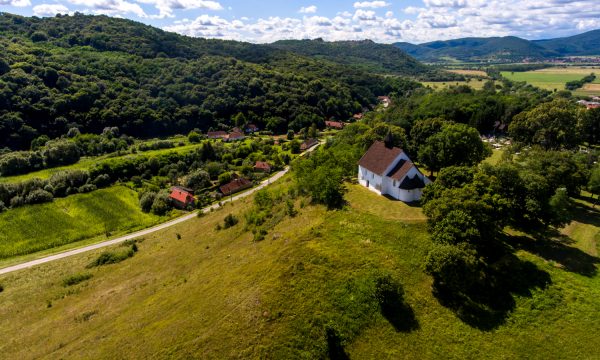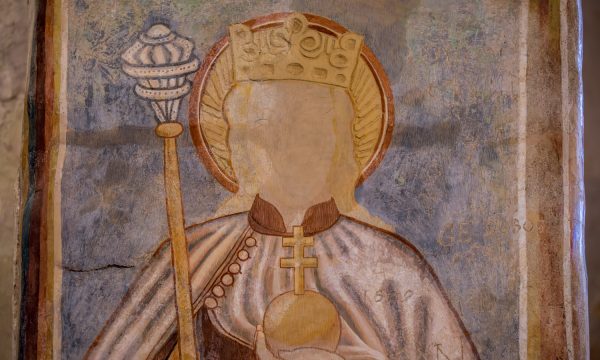Wall painting
The area, first mentioned in a document in 1198, appears in historical sources as a forest county. Torna, the smallest county of the realm, was established in the 13th century, being united with Abaúj County in 1881. Ore mining and ferrous metallurgy were common in the area until the late 12th century. The first mention of Szentandrás settlement dates from 1283. The donation of the former royal domain took place during the reign of king Béla IV. In 1243 Detre and Fülöp from the Ákos clan (the ancestors of the Bebek family) received significant royal domains in Gömör and Torna counties, where alongside Berzéte, Pelsőc, and Csetnek we also encounter the name of Szentandrás. According to a diploma issued in 1388, one of the Bebek family’s bailiffs lived in the settlement. In 1410 the family acquired the Castle of Szádvár, and Szentandrás village was attached to the estate established here. During this period 20 taxpayer households are mentioned in the settlement. By the mid-16th century, due to the Turkish advance, the settlement was slowly being depopulated. Only a handful of families lived there in the 17th century. At the end of the century, the estate of Szádvár was acquired by the Esterházy family, who in the early 18th century started to populate it with Slovak settlers from Upper Hungary.
Its church with a special layout, i.e. with twin-apses, was probably already standing in the 13th century. It is included in the register of papal tithes from 1333–34. A document from 1397 mentions its parish, and in 1493 the wife of György Putnoki made a donation to build the sacristy. By the 1570s the church of this settlement, which as a consequence of the Turkish offensive was being depopulated, also started to deteriorate. In 1713 the church was still abandoned. During the canonical visitation of 1731 it was still standing without a roof, but under the triumphal arch “…beautiful images of saints can be seen.” Its reconstruction began in 1740. It was renovated once more in 1910, but by the 1970s it got in a very bad state of conservation. In 1971, the National Monuments’ Inspectorate launched a complete restoration, starting with an archaeological research carried out by Ilona Valter, which led to the identification of two major mediaeval construction phases. The first construction phase resulted in the present chancel, which included the Arpadian twin apses and the small nave. Its expansion with a new nave occurred probably in the mid-14th century, when the members of the Bebek family were significant state dignitaries.
Its mural paintings were uncovered during the building archaeological research carried out by János Illés and Róza Szentesi. The figure of Saint Stephen depicted on the pillar separating the two apses, above it a fragment of the Last Judgement, and a representation of a holy bishop in the sedilia are all that remain from its early mural paintings. The Gothic layer is also highly damaged, but much larger coherent fragments have survived from it that are more easy to interpret. The upper, arching part of the triumphal arch’s soffit is decorated with six busts depicting prophets holding banderoles, divided into groups of three by an Agnus Dei representation in the central area, surrounded by a more ornate frame. A frame with cosmatesque decoration divides the soffit’s arched area from the vertical part, where the painter depicted two near life-sized holy kings. Their outstanding significance is emphasised by the fact that their halos and crowns have been rendered relief-like with powerful contours etched in the still wet plaster. The figure of the elder king with the orb and sceptre on the southern side can be identified as Saint Stephen. Unfortunately, the figure of king Saint Ladislaus painted on the northern pillar was only preserved from the chest upwards. This frontally represented figure with a crown decorated with fleur-de-lis motifs is wearing a close-fitting red doublet. Only his left hand holding the orb has survived, on which he wears a glove with loose sleeves. He was identified as Saint Ladislaus on the basis of his enormous battle axe seen over his shoulder. Due to deliberate vandalism, his face was destroyed in the 16th or 17th century. On the side facing the nave of the triumphal arch, in the upper register, some barely identifiable scenes have survived. A composition with several figures was painted on the lower part of its southern side. On the left a crowned figure can perhaps be identified as Constantine the Great, in the middle we see Empress Saint Helena holding the Holy Cross in her left hand, and on the right the composition is closed by three hardly identifiable secondary characters. The two larger figures are wearing ornate dresses and caps, while the third one is depicted with an uncovered head, pointing to his/her own eyes. On the lower part of the northern side a two-figure composition is depicted. A bishop represented with a halo in semi-profile stands to the left, and extends an almost unrecognisable object to the central figure that sits on a throne and is being crowned by angels with a papal tiara. His tiara and halo are emphasised, similarly to the holy kings, in a relief-like manner. This is presumably a representation of Saint Peter, as on the neighbouring northern wall we see a depiction of the Prince of apostles’ death. On this worn-out and damaged painting we can identify a figure being crucified upside down. Two paintings have survived on the nave’s southern wall. The one on the right is a Metterza (Saint Anne with the Virgin and Child), while the heads of the two figures on the left have been destroyed and their attributes cannot be recognised. However, it is certain that their garments are very fine. On the left side there is perhaps a man, while on the right side we see a female figure wearing a cloak with ermine lining.
Natural heritage
Near the village rises the Esztramos Mountain, which forms the northernmost tip of the Szalonnai Karst. The mountain, originally almost 380m tall, bears the scars of large mining operations, the destructive landscaping of mankind. Light-grey crystalline limestone used to be extracted from the now closed mine, and iron ore was also excavated from the mountain. Mining, however, also revealed several caves, the most valuable natural features of the area. Of these, the highly protected Földvári Aladár Cave and the Rákóczi Cave, at lower altitude, are the most significant. The importance of these caverns is given by their diverse physical features and the multitude and variety of natural formations found inside them. Stalactites, pisolites, and thorn-shaped, irregular helictites are all abundant here.
Through millennia, the smaller and larger hollows of the caves have preserved bones of animals from ancient times. Of these, remains of the Mimomys were found in greatest number.

The shallow topsoil on the steep mountainsides is the habitat of many rare plants. The broad-leaved helleborine (Epipactis helleborine), the white helleborine (Cephalanthera damasonium), the red helleborine (Cephalanthera rubra), and the bird’s-nest orchid (Neottia nidus-avis) are its most valuable species, as well as the Dianthus plumarius subsp. Praecox and the alpine saxifrage (Saxifraga paniculata), remnant species of the ice ages, very rare in Hungary today.

On the southern rock faces we can often see sand lizards (Lacerta agilis), European green lizards (Lacerta viridis), and sometimes European copper skinks (Ablepharus kitaibelii) as well.
Plants have taken over the terrain of the abandoned mine, and on its shrubby slopes several songbirds have made nests. On the top of the bushes, hunting red-backed shrikes (Lanius collurio) can be seen. This bird sticks the carcasses of its victims, insects, lizards, and sometimes small mammals, on the sharp ends of the blackthorn (Prunus spinosa), dog-rose (Rosa canina), or hawthorn (Crataegus) bushes. The red-backed shrike builds its nest in bushes growing along the sides of roads and ditches.
